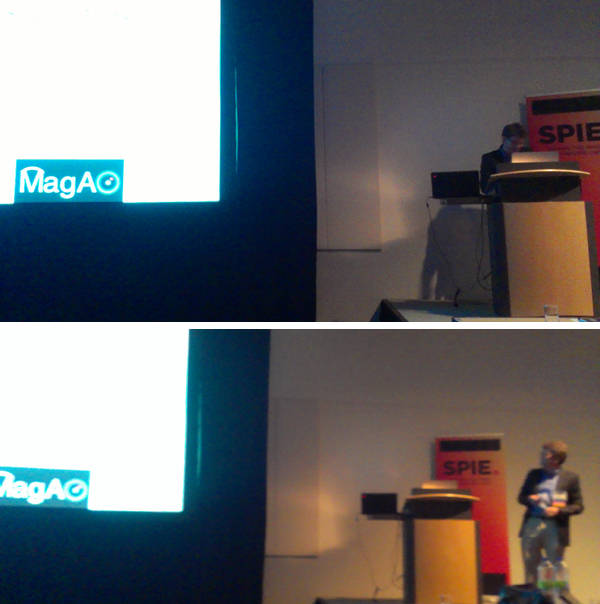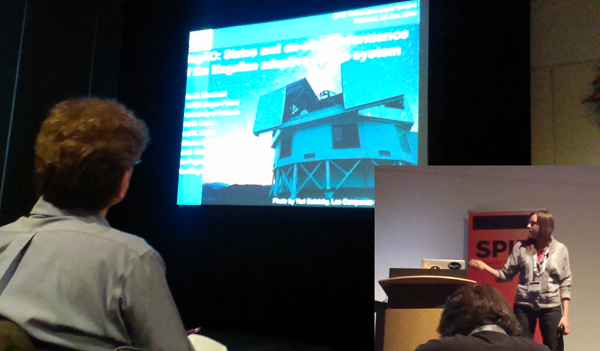Yesterday our SPIE paper pre-prints were announced on the astro-ph ArXiv. In case you missed it, here’s a run-down:
Into the Blue: AO Science with MagAO in the Visible (Invited Talk)
Laird M. Close, Jared R. Males, Katherine B. Follette, Phil Hinz, Katie M. Morzinski, Ya-Lin Wu, Derek Kopon, Armando Riccardi, Simone Esposito, Alfio Puglisi, Enrico Pinna, Marco Xompero, Runa Briguglio, Fernando Quiros-Pacheco
We review astronomical results in the visible ({\lambda}<1{\mu}m) with adaptive optics. Other than a brief period in the early 1990s, there has been little astronomical science done in the visible with AO until recently. The most productive visible AO system to date is our 6.5m Magellan telescope AO system (MagAO). MagAO is an advanced Adaptive Secondary system at the Magellan 6.5m in Chile. This secondary has 585 actuators with < 1 msec response times (0.7 ms typically). We use a pyramid wavefront sensor. The relatively small actuator pitch (~23 cm/subap) allows moderate Strehls to be obtained in the visible (0.63-1.05 microns). We use a CCD AO science camera called "VisAO". On-sky long exposures (60s) achieve <30mas resolutions, 30% Strehls at 0.62 microns (r') with the VisAO camera in 0.5" seeing with bright R < 8 mag stars. These relatively high visible wavelength Strehls are made possible by our powerful combination of a next generation ASM and a Pyramid WFS with 378 controlled modes and 1000 Hz loop frequency. We'll review the key steps to having good performance in the visible and review the exciting new AO visible science opportunities and refereed publications in both broad-band (r,i,z,Y) and at Halpha for exoplanets, protoplanetary disks, young stars, and emission line jets. These examples highlight the power of visible AO to probe circumstellar regions/spatial resolutions that would otherwise require much larger diameter telescopes with classical infrared AO cameras.
MagAO: Status and on-sky performance of the Magellan adaptive optics system
Katie M. Morzinski, Laird M. Close, Jared R. Males, Derek Kopon, Phil M. Hinz, Simone Esposito, Armando Riccardi, Alfio Puglisi, Enrico Pinna, Runa Briguglio, Marco Xompero, Fernando Quirós-Pacheco, Vanessa Bailey, Katherine B. Follette, T. J. Rodigas, Ya-Lin Wu, Carmelo Arcidiacono, Javier Argomedo, Lorenzo Busoni, Tyson Hare, Alan Uomoto, Alycia Weinberger
MagAO is the new adaptive optics system with visible-light and infrared science cameras, located on the 6.5-m Magellan “Clay” telescope at Las Campanas Observatory, Chile. The instrument locks on natural guide stars (NGS) from 0th to 16th R-band magnitude, measures turbulence with a modulating pyramid wavefront sensor binnable from 28×28 to 7×7 subapertures, and uses a 585-actuator adaptive secondary mirror (ASM) to provide flat wavefronts to the two science cameras. MagAO is a mutated clone of the similar AO systems at the Large Binocular Telescope (LBT) at Mt. Graham, Arizona. The high-level AO loop controls up to 378 modes and operates at frame rates up to 1000 Hz. The instrument has two science cameras: VisAO operating from 0.5-1 μm and Clio2 operating from 1-5 μm. MagAO was installed in 2012 and successfully completed two commissioning runs in 2012-2013. In April 2014 we had our first science run that was open to the general Magellan community. Observers from Arizona, Carnegie, Australia, Harvard, MIT, Michigan, and Chile took observations in collaboration with the MagAO instrument team. Here we describe the MagAO instrument, describe our on-sky performance, and report our status as of summer 2014.
Direct imaging of exoplanets in the habitable zone with adaptive optics (Invited Talk)
Jared R. Males, Laird M. Close, Olivier Guyon, Katie M. Morzinski, Alfio Puglisi, Philip Hinz, Katherine B. Follette, John D. Monnier, Volker Tolls, Timothy J. Rodigas, Alycia Weinberger, Alan Boss, Derek Kopon, Ya-lin Wu, Simone Esposito, Armando Riccardi, Marco Xompero, Runa Briguglio, Enrico Pinna
One of the primary goals of exoplanet science is to find and characterize habitable planets, and direct imaging will play a key role in this effort. Though imaging a true Earth analog is likely out of reach from the ground, the coming generation of giant telescopes will find and characterize many planets in and near the habitable zones (HZs) of nearby stars. Radial velocity and transit searches indicate that such planets are common, but imaging them will require achieving extreme contrasts at very small angular separations, posing many challenges for adaptive optics (AO) system design. Giant planets in the HZ may even be within reach with the latest generation of high-contrast imagers for a handful of very nearby stars. Here we will review the definition of the HZ, and the characteristics of detectable planets there. We then review some of the ways that direct imaging in the HZ will be different from the typical exoplanet imaging survey today. Finally, we present preliminary results from our observations of the HZ of {\alpha} Centauri A with the Magellan AO system’s VisAO and Clio2 cameras.

And here are some pictures from the conference, which was the SPIE Astronomical Telescopes and Instrumentation conference in Montreal in June. You can check out #SPIEastro to find out more about the general topics covered at the conference.




